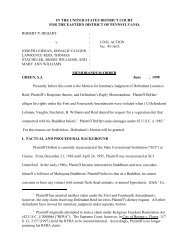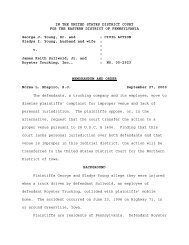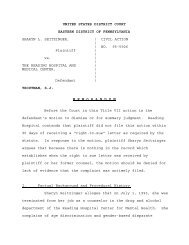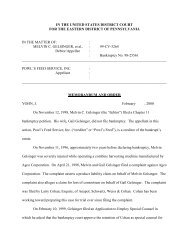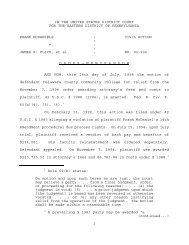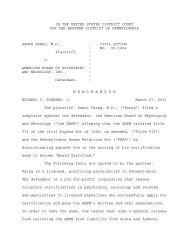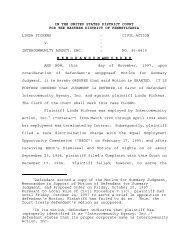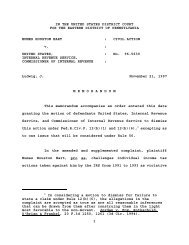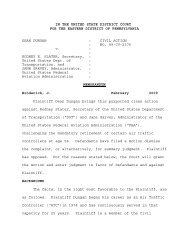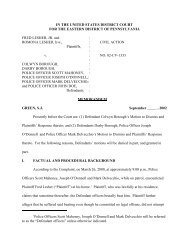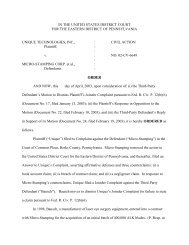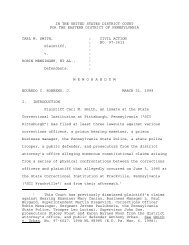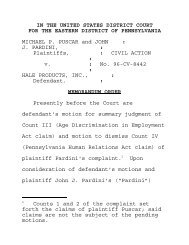for the eastern district of pennsylvania thomas s. washam
for the eastern district of pennsylvania thomas s. washam
for the eastern district of pennsylvania thomas s. washam
Create successful ePaper yourself
Turn your PDF publications into a flip-book with our unique Google optimized e-Paper software.
IN THE UNITED STATES DISTRICT COURT<br />
FOR THE EASTERN DISTRICT OF PENNSYLVANIA<br />
THOMAS S. WASHAM, : CIVIL ACTION<br />
Petitioner :<br />
:<br />
v. :<br />
:<br />
DELAWARE COUNTY COURT : NO. 95–5697<br />
OF COMMON PLEAS, et al., :<br />
Respondents :<br />
MEMORANDUM<br />
BUCKWALTER, S.J. December 5, 2006<br />
Presently be<strong>for</strong>e <strong>the</strong> Court are Petitioner’s Motion Pursuant to Federal Rule <strong>of</strong><br />
Civil Procedure 60(b) (Docket No. 14) and Respondents’ response <strong>the</strong>reto (Docket No. 19). For<br />
<strong>the</strong> reasons stated below, Petitioner’s Motion Pursuant to F.R.C.P. 60(b) is denied.<br />
I. PROCEDURAL HISTORY<br />
On October 23, 1987, following a jury trial in <strong>the</strong> Court <strong>of</strong> Common Pleas <strong>of</strong><br />
Delaware County, Pennsylvania, Petitioner was convicted <strong>of</strong> first degree murder, possession <strong>of</strong><br />
an instrument <strong>of</strong> crime, and possession <strong>of</strong> a firearm without a license. 1 Subsequently, Petitioner<br />
was sentenced to life in prison <strong>for</strong> murder and concurrent sentences <strong>of</strong> two to five years<br />
imprisonment <strong>for</strong> each <strong>of</strong> <strong>the</strong> weapons <strong>of</strong>fenses. Petitioner appealed to <strong>the</strong> Pennsylvania<br />
1. The facts set <strong>for</strong>th in this procedural history have been taken from <strong>the</strong> Report and Recommendation (Docket No.<br />
6) <strong>of</strong> <strong>the</strong> Honorable Arnold C. Rapoport, United States Magistrate Judge, derived from <strong>the</strong> Petitioner’s Petition <strong>for</strong><br />
Writ <strong>of</strong> Habeas Corpus (Docket No. 1), <strong>the</strong> District Attorney’s Response <strong>the</strong>reto (Docket No. 4), and <strong>the</strong> state court<br />
record.
Superior Court, and on March 9, 1990, <strong>the</strong> Superior Court affirmed <strong>the</strong> judgment <strong>of</strong> sentence.<br />
Discretionary review by <strong>the</strong> Pennsylvania Supreme Court was denied on March 22, 1991.<br />
On May 24, 1991, Petitioner sought relief under <strong>the</strong> Post Conviction Relief Act<br />
(“PCRA”), 42 Pa. C.S.A. § 9541, et seq. Counsel was appointed and Petitioner’s argument was<br />
heard at a hearing. Petitioner’s PCRA petition was denied on November 22, 1991. Petitioner<br />
subsequently filed a timely appeal to <strong>the</strong> Superior Court. On November 24, 1993, <strong>the</strong> Superior<br />
Court affirmed <strong>the</strong> judgment <strong>of</strong> <strong>the</strong> PCRA court, finding Petitioner’s claim to be without merit.<br />
Petitioner <strong>the</strong>n sought discretionary review by <strong>the</strong> Pennsylvania Supreme Court, which was<br />
denied on March 30, 1995.<br />
On September 8, 1995, Petitioner filed in this court a pro se petition <strong>for</strong> a writ <strong>of</strong><br />
habeas corpus pursuant to 28 U.S.C. § 2254. As grounds <strong>for</strong> relief, Petitioner alleged violations<br />
<strong>of</strong> his Constitutional rights due to (1) illegally obtained testimony in violation <strong>of</strong> spousal<br />
immunity; (2) ineffective trial counsel; (3) improper admission <strong>of</strong> evidence <strong>of</strong> prior bad acts; and<br />
(4) prosecutorial misconduct in failing to present a witness <strong>for</strong> cross-examination. Amongst<br />
o<strong>the</strong>r specific allegations, Petitioner’s ineffective counsel claim alleged counsel’s failure to<br />
secure Petitioner’s presence during robing room conferences. The habeas petition was referred to<br />
Magistrate Judge Arnold C. Rapoport who subsequently recommended its dismissal, finding that<br />
certain grounds are procedurally defaulted and ineffective assistance <strong>of</strong> counsel in a state<br />
collateral proceeding is no basis <strong>for</strong> habeas relief. Despite Petitioner’s timely objections, on<br />
January 3, 1996, this court approved and adopted <strong>the</strong> Report and Recommendation <strong>of</strong> Magistrate<br />
Judge Arnold C. Rapoport and dismissed <strong>the</strong> petition. Petitioner subsequently appealed to <strong>the</strong><br />
United States Court <strong>of</strong> Appeals <strong>for</strong> <strong>the</strong> Third Circuit, requesting an issuance <strong>of</strong> a Certificate <strong>of</strong><br />
2
Probable Cause <strong>for</strong> Appeal from <strong>the</strong> denial <strong>of</strong> his habeas petition. The Third Circuit denied<br />
Petitioner’s request <strong>for</strong> a Certificate <strong>of</strong> Probable Cause on November 8, 1996, finding that<br />
Petitioner’s claims were non-cognizable, procedurally defaulted, or failed to make a substantial<br />
showing <strong>of</strong> <strong>the</strong> denial <strong>of</strong> a federal right.<br />
On December 18, 2000, Petitioner filed a second or successive petition <strong>for</strong> writ <strong>of</strong><br />
habeas corpus pursuant to 28 U.S.C. § 2254, 00-cv-6388. On February 20, 2001, this court<br />
dismissed with prejudice four <strong>of</strong> Petitioner’s five claims, finding that <strong>the</strong>y were presented in <strong>the</strong><br />
prior petition. Petitioner’s fifth claim, relating to <strong>the</strong> demographics <strong>of</strong> <strong>the</strong> county in which he<br />
was tried, was dismissed without prejudice to Petitioner’s right to seek an Order from <strong>the</strong> Third<br />
Circuit authorizing this court to consider this claim. On August 20, 2001, <strong>the</strong> Third Circuit<br />
denied Petitioner’s request to file a second or successive habeas petition pursuant to 28 U.S.C. §<br />
2244(b).<br />
Presently be<strong>for</strong>e <strong>the</strong> Court is Petitioner’s Motion Pursuant to Federal Rules <strong>of</strong><br />
Civil Procedure 60(b). Petitioner claims that despite appearances, <strong>the</strong> instant motion is not<br />
effectively a successive habeas petition. Petitioner claims that he is entitled to relief because <strong>the</strong><br />
transcript from his trial is incomplete. Specifically, Petitioner argues that his previously asserted<br />
“Batson” claim 2 would not have been determined procedurally defaulted had a transcription <strong>of</strong><br />
<strong>the</strong> Prosecution’s peremptory strikes been available.<br />
2. See Batson v. Kentucky, 476 U.S. 79 (1986), where <strong>the</strong> United States Supreme Court held that <strong>the</strong> Equal<br />
Protection Clause <strong>of</strong> <strong>the</strong> Constitution <strong>for</strong>bids prosecutors from striking potential jurors based solely on <strong>the</strong> account <strong>of</strong><br />
<strong>the</strong>ir race.<br />
Petitioner states that <strong>the</strong> “nucleus <strong>of</strong> [his] Batson claim can be found in <strong>the</strong> original Habeas Corpus<br />
action ... filed September 8, 1995.” (Petitioner’s Mot. Pursuant to F.R.C.P. 60(b) at 5). Petitioner’s Batson claim<br />
was first expressed in detail in his third pro se petition filed in <strong>the</strong> Court <strong>of</strong> Common Pleas <strong>of</strong> Delaware County<br />
under <strong>the</strong> Pennsylvania Post-Conviction Relief Act. (Respondents’ Response Motion at 3).<br />
3
II. DISCUSSION<br />
Federal Rule <strong>of</strong> Civil Procedure 60(b) permits “a party to seek relief from a final<br />
judgment ... under a limited set <strong>of</strong> circumstances including fraud, mistake, and newly discovered<br />
evidence. 3<br />
Gonzalez v. Crosby, 545 U.S. 524, 125 S.Ct. 2641, 2645 (2005). However, be<strong>for</strong>e<br />
proceeding with Petitioner’s Rule 60(b) motion, <strong>the</strong> Court must first determine whe<strong>the</strong>r or not<br />
<strong>the</strong> motion is, in essence, a second or successive habeas motion. This is because <strong>the</strong><br />
Antiterrorism and Effective Death Penalty Act <strong>of</strong> 1996 (“AEDPA”), 28 U.S.C. §§2241-2266,<br />
addresses <strong>the</strong> right <strong>of</strong> all persons in state or federal custody to file a petition in a federal court<br />
seeking <strong>the</strong> issuance <strong>of</strong> a writ <strong>of</strong> habeas corpus. AEDPA contains a series <strong>of</strong> restrictions, one <strong>of</strong><br />
which is AEDPA’s successive-petition provision, which imposes three requirements on second<br />
or successive habeas petitions:<br />
First, any claim that has already been adjudicated in a previous petition must be<br />
dismissed. § 2244(b)(1). Second, any claim that has not already been adjudicated<br />
must be dismissed unless it relies on ei<strong>the</strong>r a new and retroactive rule <strong>of</strong><br />
constitutional law or new facts showing a high probability <strong>of</strong> actual innocence. §<br />
2244(b)(2). Third, be<strong>for</strong>e <strong>the</strong> <strong>district</strong> court may accept a successive petition <strong>for</strong><br />
filing, <strong>the</strong> court <strong>of</strong> appeals must determine that it presents a claim not previously<br />
raised that is sufficient to meet § 2244(b)(s)’s new-rule or actual-innocence<br />
provisions. § 2244(b)(3).<br />
Gonzalez v. Crosby, 545 U.S. 524, 125 S.Ct. at 2646. In Gonzalez v. Crosby, <strong>the</strong> Supreme Court<br />
<strong>of</strong> <strong>the</strong> United States held that a Rule 60(b) motion challenging <strong>the</strong> underlying state conviction<br />
3. F.R.C.P. 60(b) provides in relevant part:<br />
“On motion and upon such terms as are just, <strong>the</strong> court may relieve a party or a party’s legal representative from a<br />
final judgment order, or proceeding <strong>for</strong> <strong>the</strong> following reasons: (1) mistake, inadvertence, surprise, or excusable<br />
neglect; (2) newly discovered evidence which by due diligence could not have been discovered in time to move <strong>for</strong> a<br />
new trial under Rule 59(b); (3) fraud (whe<strong>the</strong>r hereto<strong>for</strong>e denominated intrinsic or extrinsic), misrepresentation, or<br />
o<strong>the</strong>r misconduct <strong>of</strong> an adverse party; (4) <strong>the</strong> judgment is void; (5) <strong>the</strong> judgment has been satisfied, released, or<br />
discharged, or a prior judgment upon which it is based has been reversed or o<strong>the</strong>rwise vacated, or it is no longer<br />
equitable that <strong>the</strong> judgment should have prospective application; or (6) any o<strong>the</strong>r reasons justifying relief from <strong>the</strong><br />
operation <strong>of</strong> <strong>the</strong> judgment”<br />
4
qualifies as a second or successive habeas petition, thus subjecting <strong>the</strong> motion to AEDPA’s<br />
successive-petition restrictions. Gonzalez, 545 U.S. 524, 125 S.Ct. at 2648; See, also, Pridgen v.<br />
Shannon, 380 F.3d 721, 727 (3d Cir. 2004).<br />
In <strong>the</strong> instant case, Petitioner’s motion pursuant to Rule 60(b) clearly challenges<br />
<strong>the</strong> underlying state conviction and can <strong>the</strong>re<strong>for</strong>e only be construed as a second or successive<br />
habeas petition. Petitioner’s Batson claim ultimately asserts a claim <strong>of</strong> error in his state<br />
conviction. Through this claim, Petitioner seeks relief <strong>of</strong> all prior judgments due to purported<br />
racial discrimination in <strong>the</strong> jury selection process. Likewise, Petitioner’s specific arguments<br />
alleging fraud and violations <strong>of</strong> due process through <strong>the</strong> deliberate concealment <strong>of</strong> peremptory<br />
strikes from <strong>the</strong> trial transcript, while unfounded, never<strong>the</strong>less assert claims <strong>of</strong> error in<br />
Petitioner’s underlying state conviction. As previously mentioned, a Rule 60(b) motion<br />
challenging <strong>the</strong> underlying state conviction is, in essence, a second or successive habeas and<br />
must be handled accordingly. Gonzalez, 545 U.S. 524, 125 S.Ct. at 2649; Pridgen, 380 F.3d at<br />
727.<br />
Under AEDPA, this Court may not consider a second or successive habeas corpus<br />
petition (or as in this case, a motion pursuant to Rule 60(b) determined to be, in essence, a<br />
second or successive habeas petition) prior to obtaining an order from <strong>the</strong> Court <strong>of</strong> Appeals <strong>for</strong><br />
<strong>the</strong> Third Circuit. See AEDPA, 28 U.S.C. § 2244(b)(3). The Court must <strong>the</strong>re<strong>for</strong>e dismiss<br />
Petitioner’s motion pursuant to Rule 60(b) as an unauthorized habeas petition.<br />
Petitioner has noted that Respondent’s response was untimely (by 5 days). While<br />
Respondent should file in accordance with court orders, and untimely practice is not condoned,<br />
5
<strong>the</strong> Court sees no prejudice caused by <strong>the</strong> untimely response found here. An appropriate order<br />
follows.<br />
6
IN THE UNITED STATES DISTRICT COURT<br />
FOR THE EASTERN DISTRICT OF PENNSYLVANIA<br />
THOMAS S. WASHAM, : CIVIL ACTION<br />
Petitioner :<br />
:<br />
v. :<br />
:<br />
DELAWARE COUNTY COURT : NO. 95–5697<br />
OF COMMON PLEAS, et al., :<br />
Respondents :<br />
ORDER<br />
AND NOW, this 5 th day <strong>of</strong> December, 2006, it is hereby ORDERED that<br />
Plaintiff’s Motion Pursuant to Federal Rule <strong>of</strong> Civil Procedure 60(b) (Docket No. 14) is<br />
DISMISSED.<br />
IT IS FURTHER ORDERED that no certificate <strong>of</strong> appealability will issue on<br />
<strong>the</strong> ground that Petitioner has failed to make a substantial showing <strong>of</strong> a denial <strong>of</strong> a constitutional<br />
right.<br />
BY THE COURT:<br />
_____________________________________<br />
RONALD L. BUCKWALTER, S.J.



